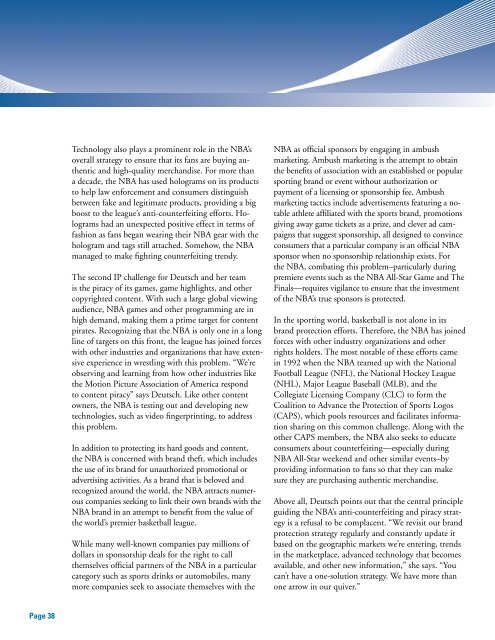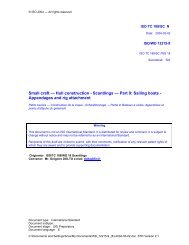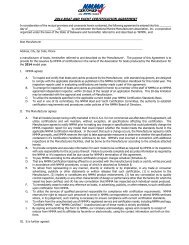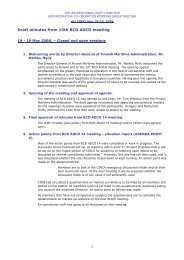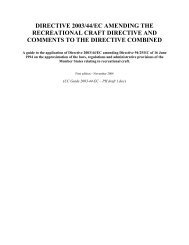Intellectual Property Protection and Enforcement Manual - Ipr-policy.eu
Intellectual Property Protection and Enforcement Manual - Ipr-policy.eu
Intellectual Property Protection and Enforcement Manual - Ipr-policy.eu
You also want an ePaper? Increase the reach of your titles
YUMPU automatically turns print PDFs into web optimized ePapers that Google loves.
Technology also plays a prominent role in the NBA’s<br />
overall strategy to ensure that its fans are buying authentic<br />
<strong>and</strong> high-quality merch<strong>and</strong>ise. For more than<br />
a decade, the NBA has used holograms on its products<br />
to help law enforcement <strong>and</strong> consumers distinguish<br />
between fake <strong>and</strong> legitimate products, providing a big<br />
boost to the league’s anti-counterfeiting efforts. Holograms<br />
had an unexpected positive effect in terms of<br />
fashion as fans began wearing their NBA gear with the<br />
hologram <strong>and</strong> tags still attached. Somehow, the NBA<br />
managed to make fighting counterfeiting trendy.<br />
The second IP challenge for D<strong>eu</strong>tsch <strong>and</strong> her team<br />
is the piracy of its games, game highlights, <strong>and</strong> other<br />
copyrighted content. With such a large global viewing<br />
audience, NBA games <strong>and</strong> other programming are in<br />
high dem<strong>and</strong>, making them a prime target for content<br />
pirates. Recognizing that the NBA is only one in a long<br />
line of targets on this front, the league has joined forces<br />
with other industries <strong>and</strong> organizations that have extensive<br />
experience in wrestling with this problem. “We’re<br />
observing <strong>and</strong> learning from how other industries like<br />
the Motion Picture Association of America respond<br />
to content piracy” says D<strong>eu</strong>tsch. Like other content<br />
owners, the NBA is testing out <strong>and</strong> developing new<br />
technologies, such as video fingerprinting, to address<br />
this problem.<br />
In addition to protecting its hard goods <strong>and</strong> content,<br />
the NBA is concerned with br<strong>and</strong> theft, which includes<br />
the use of its br<strong>and</strong> for unauthorized promotional or<br />
advertising activities. As a br<strong>and</strong> that is beloved <strong>and</strong><br />
recognized around the world, the NBA attracts numerous<br />
companies seeking to link their own br<strong>and</strong>s with the<br />
NBA br<strong>and</strong> in an attempt to benefit from the value of<br />
the world’s premier basketball league.<br />
While many well-known companies pay millions of<br />
dollars in sponsorship deals for the right to call<br />
themselves official partners of the NBA in a particular<br />
category such as sports drinks or automobiles, many<br />
more companies seek to associate themselves with the<br />
NBA as official sponsors by engaging in ambush<br />
marketing. Ambush marketing is the attempt to obtain<br />
the benefits of association with an established or popular<br />
sporting br<strong>and</strong> or event without authorization or<br />
payment of a licensing or sponsorship fee. Ambush<br />
marketing tactics include advertisements featuring a notable<br />
athlete affiliated with the sports br<strong>and</strong>, promotions<br />
giving away game tickets as a prize, <strong>and</strong> clever ad campaigns<br />
that suggest sponsorship, all designed to convince<br />
consumers that a particular company is an official NBA<br />
sponsor when no sponsorship relationship exists. For<br />
the NBA, combating this problem–particularly during<br />
premiere events such as the NBA All-Star Game <strong>and</strong> The<br />
Finals—requires vigilance to ensure that the investment<br />
of the NBA’s true sponsors is protected.<br />
In the sporting world, basketball is not alone in its<br />
br<strong>and</strong> protection efforts. Therefore, the NBA has joined<br />
forces with other industry organizations <strong>and</strong> other<br />
rights holders. The most notable of these efforts came<br />
in 1992 when the NBA teamed up with the National<br />
Football League (NFL), the National Hockey League<br />
(NHL), Major League Baseball (MLB), <strong>and</strong> the<br />
Collegiate Licensing Company (CLC) to form the<br />
Coalition to Advance the <strong>Protection</strong> of Sports Logos<br />
(CAPS), which pools resources <strong>and</strong> facilitates information<br />
sharing on this common challenge. Along with the<br />
other CAPS members, the NBA also seeks to educate<br />
consumers about counterfeiting—especially during<br />
NBA All-Star weekend <strong>and</strong> other similar events–by<br />
providing information to fans so that they can make<br />
sure they are purchasing authentic merch<strong>and</strong>ise.<br />
Above all, D<strong>eu</strong>tsch points out that the central principle<br />
guiding the NBA’s anti-counterfeiting <strong>and</strong> piracy strategy<br />
is a refusal to be complacent. “We revisit our br<strong>and</strong><br />
protection strategy regularly <strong>and</strong> constantly update it<br />
based on the geographic markets we’re entering, trends<br />
in the marketplace, advanced technology that becomes<br />
available, <strong>and</strong> other new information,” she says. “You<br />
can’t have a one-solution strategy. We have more than<br />
one arrow in our quiver.”<br />
Page 38


